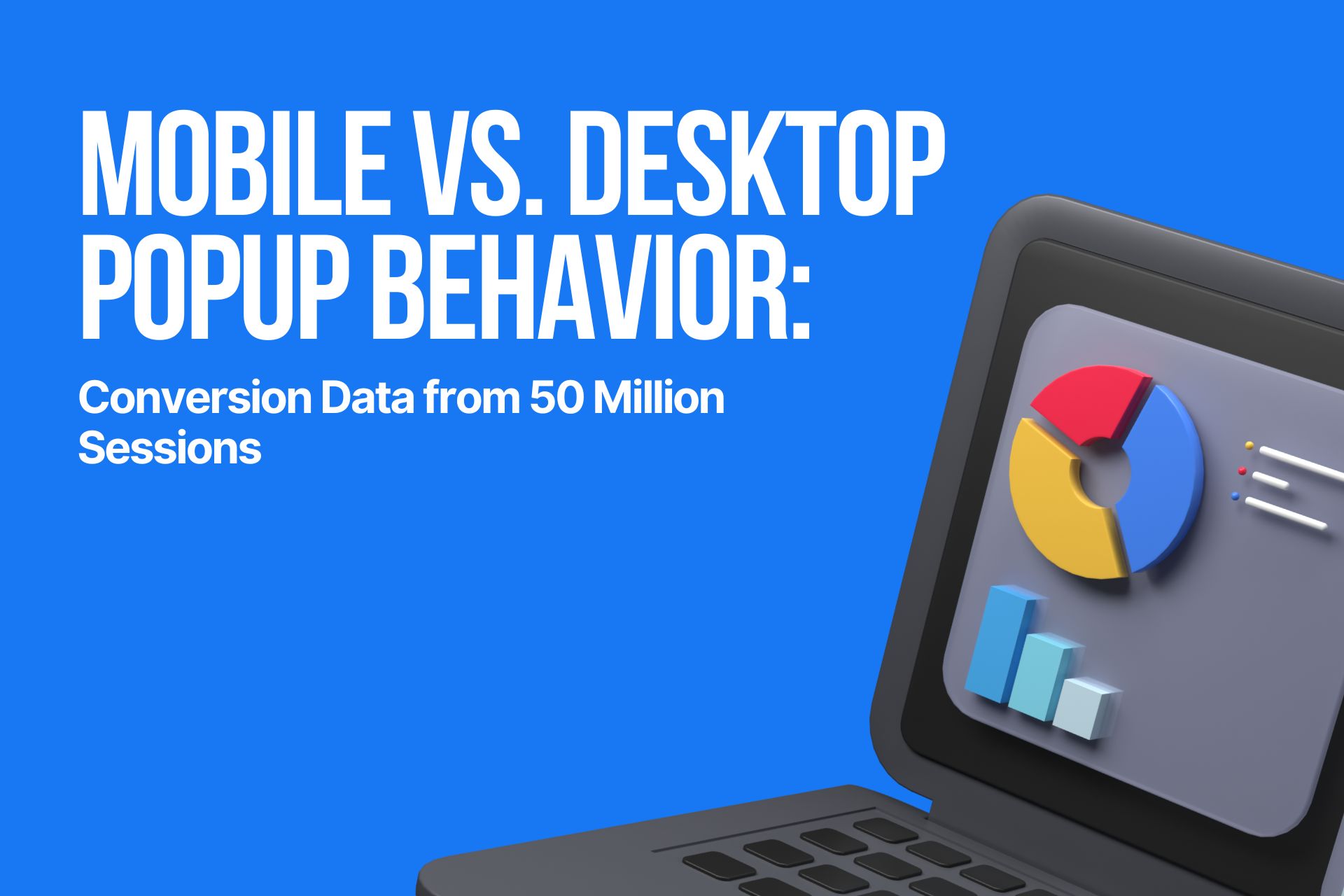⚡ Quick Summary by Popupsmart
In this post, I’ll share what I learned from analyzing over 50 million popup sessions, and how mobile vs. desktop behavior shapes every campaign’s success.
You’ll discover:
- 📱 Why mobile users engage faster but convert differently
- 💻 How desktop visitors behave when intent and patience collide
- ⏱ The ideal timing and trigger strategies for each device
- 🧠 The psychology behind on-screen attention and decision-making
- 💡 Practical tips to design adaptive popups that feel seamless on every screen
If you’ve ever wondered why your popups perform better on one device than another, or how to close that gap, this post will give you the data, the context, and the tactics to do it right.
📊 Device-Level Performance Insights
In analyzing more than 50 million popup sessions from campaigns across e-commerce, SaaS, and content platforms, one trend continues to stand out: device type defines both the tempo and the intent of user engagement. Popups that perform beautifully on desktop often underdeliver on mobile; not because the offer changes, but because user context does.
📱 Mobile Popups at a Glance
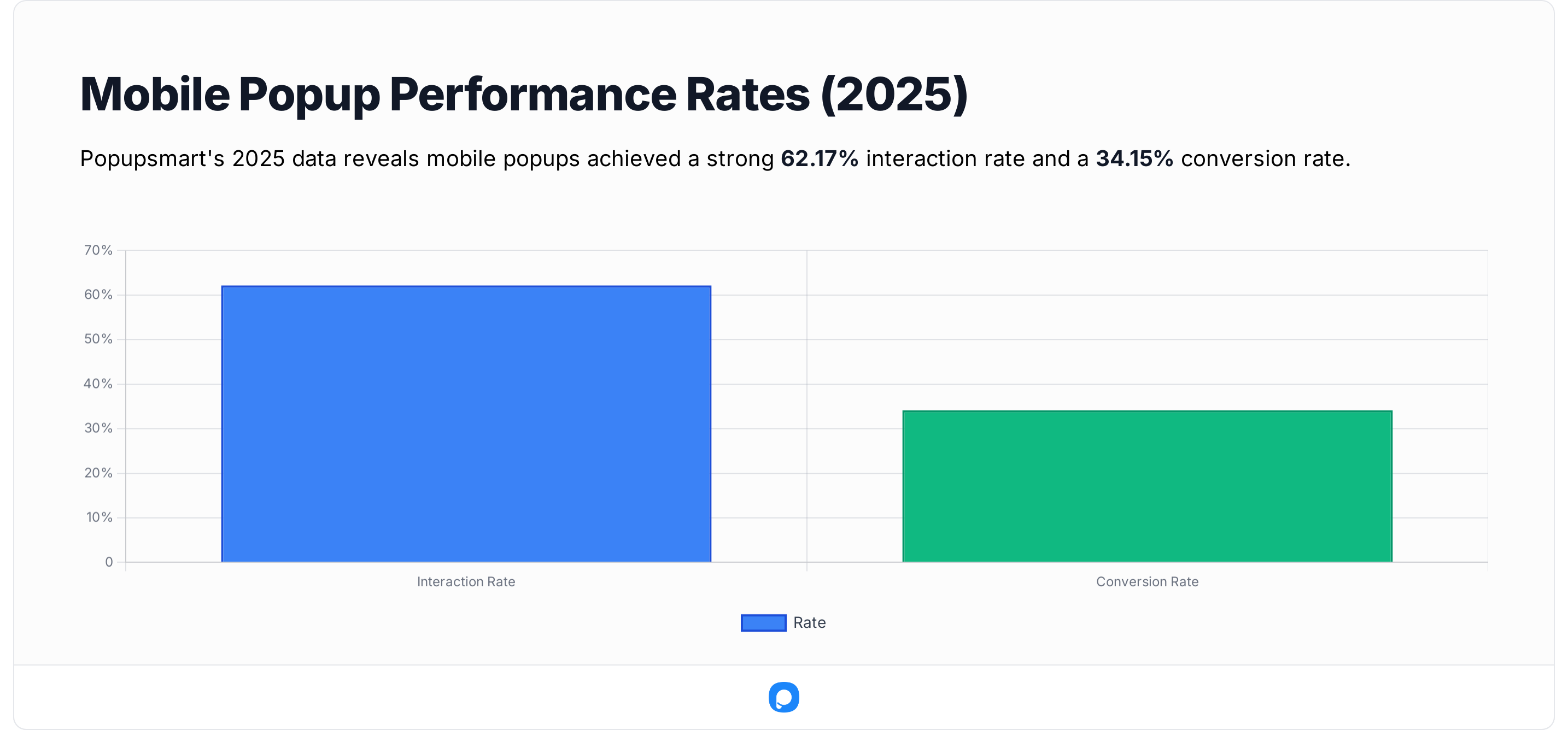
From Popupsmart’s 2025 dataset, mobile popups achieved an average interaction rate of 62.17% and a conversion rate of 34.15%. These results align closely with wider market research on mobile user behavior.
Recent studies indicate that mobile now drives roughly 65–70% of all web traffic globally, yet mobile conversion rates remain significantly lower than desktop—often between 1.2% and 2.9% on average.
The pattern makes sense. Mobile browsing often happens during brief, multitasking sessions—scrolling while commuting, checking updates during breaks, or researching products casually. In such moments, attention spans shrink, and impulse reactions dominate. Popups still attract taps and swipes, but the commitment threshold is higher.
Psychologically, this behavior fits what is called “micro-moment engagement”: a mobile user reacts instantly to an on-screen prompt but abandons it just as fast if friction appears.
For mobile campaigns, the most effective popups are fast, clear, and friction-free—short forms, bold CTAs, and no redundant text.
💻 Desktop Popups at a Glance
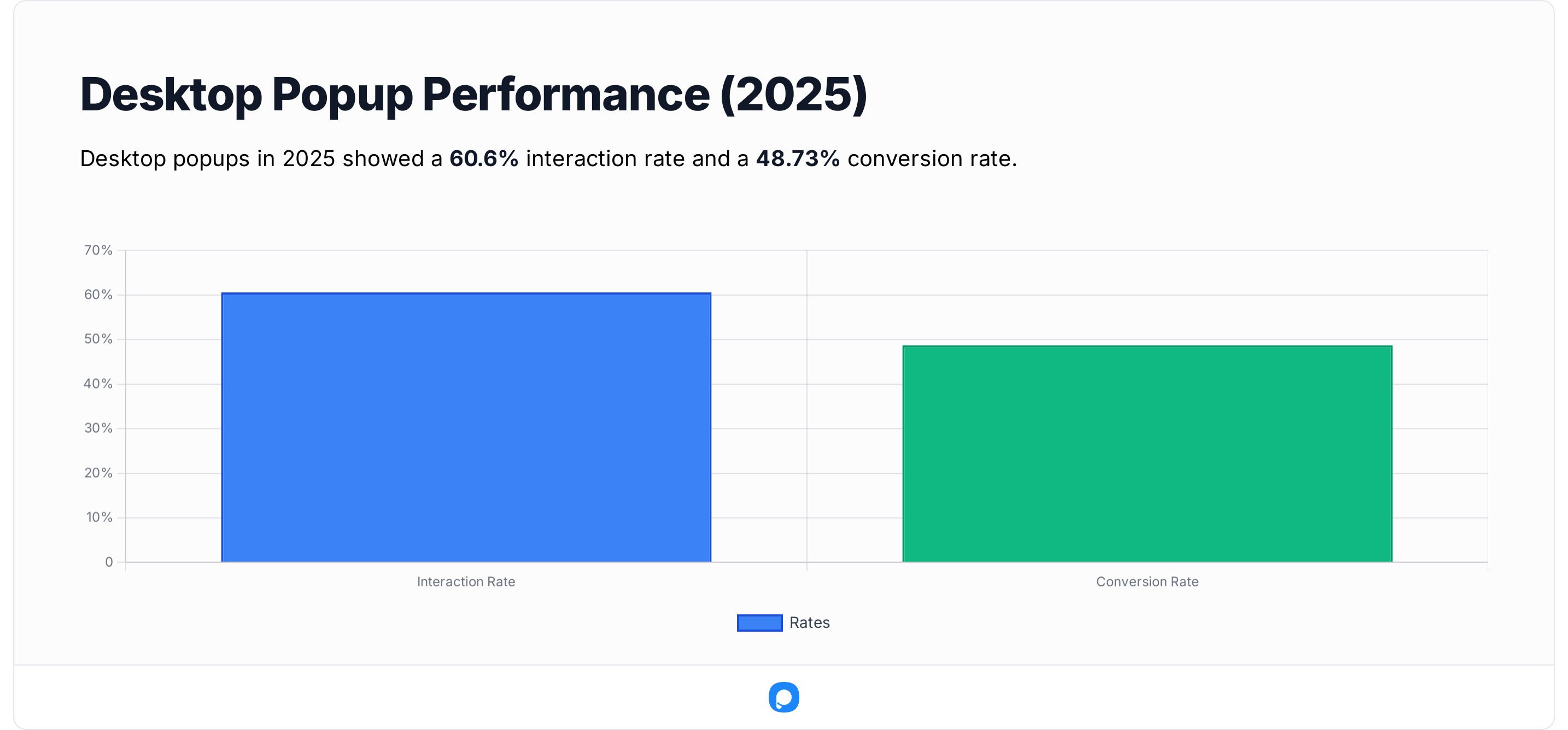
Desktop users show a different rhythm altogether. In Popupsmart’s 2025 dataset, desktop popups averaged a 60.6% interaction rate but a stronger 48.73% conversion rate, suggesting a more deliberate decision pattern.
External research mirrors these results. Smart Insights found that desktop traffic continues to convert at roughly 1.7× the rate of mobile, largely due to higher session depth and reduced task switching. Similarly, SEMrush’s Web Usage Report showed that desktop sessions average nearly 40–70% longer durations than mobile, giving popups more room to appear at the right psychological moment.
In my experience, desktop users approach offers with greater cognitive investment. They often arrive with a research mindset, browse multiple tabs, and evaluate before clicking. This creates the ideal environment for time-on-page triggers and multi-step popups that add context rather than interrupt.
⚖️ Mobile vs. Desktop: The Big Picture
Across all datasets, one theme keeps reappearing: engagement is no longer the bottleneck—context is.
Mobile users engage quickly because their experience is fleeting; desktop users engage meaningfully because they have time to think. Each device, therefore, demands its own pacing, message density, and trigger design.
⏱ Timing Is Everything: Optimal Trigger Strategies by Device
If there’s one truth I’ve seen confirmed over and over again, it’s this:
⏰ The right popup shown at the wrong time converts like the wrong popup.
Timing defines whether a message feels helpful or interruptive.
Based on Popupsmart’s 2025 session data and several UX research sources, the ideal trigger window differs sharply between desktop and mobile users.
💻 Desktop: The “Wait, Then Win” Strategy
Desktop visitors browse with more patience and context. They scroll deeper, explore more, and multitask less, which means popups can wait a little before showing up.
🧩 Data-backed sweet spot (Popupsmart 2025):
- Time-on-page trigger: 8–12 seconds after page load
- Scroll-depth trigger: 35–50% of page height
- Exit-intent popups: +20–25% lift in conversion compared to instant popups
📚 Why it works:
- Nielsen Norman Group advises that most popups appear at the wrong time and interrupt tasks; popups should not be shown before user interaction or during critical tasks.
- Baymard recommends avoiding overlays on page load and highlights problems when overlays don’t respect expected navigation (e.g., back-button behavior). These findings support triggering overlays after user action rather than on load.
✅ Best-performing triggers on desktop:
- ⏱ Time delay: 8–12 seconds after engagement
- 📜 Scroll-based: 40–50% depth for long-form pages
- 🚪 Exit intent: cart, checkout, or long dwell sessions
- 🎯 Multi-step popups: great for demo, quote, or sign-up forms
🧠 In essence: desktop users reward patience and precision. Popups that appear after interest is shown—not before—convert with higher intent and lower bounce rates.
📱 Mobile: The “Catch the Micro-Moment” Strategy
Mobile browsing is fast, fragmented, and full of distractions. The timing must adapt to short attention spans and thumb-driven interaction.
📊 Popupsmart 2025 findings:
- Popups shown after 5–7 seconds of engagement performed 40% better than those triggered instantly.
- Scroll-based triggers (20–30%) achieved the highest interaction rates on mobile.
📚 Supporting research:
- Think with Google reports that 53% of mobile visits are abandoned if a site takes longer than 3 seconds to load (speed is decisive early in the visit).
- Think with Google shows a 0.1s decrease in mobile site load time increased retail conversion rates by 8.4%, underscoring behavior-based and performance-timing gains.
✅ Best-performing triggers on mobile:
- ⏱ Time delay: 5–7 seconds after active scrolling or tap
- 📜 Scroll-based: 25–30% of page height for blogs
- 🛒 Event-based: after “Add to Cart” or “View More” actions
- ❌ Avoid: instant load popups — they spike bounce rates by up to 38%
💡 The key is subtlety. Popups should feel like they belong to the user journey, not interrupt it. On mobile, that often means one gentle prompt, perfectly timed.
🕹 Timing Benchmarks at a Glance
🧩 Takeaway
Every popup lives or dies by when it shows up.
A desktop visitor wants time to evaluate. A mobile visitor reacts in a blink.
The most successful campaigns in Popupsmart’s 2025 dataset were those that matched timing to intent—popups that waited for a signal, not a guess.
🧠 What Psychology Tells Us About Mobile vs. Desktop Attention
When it comes to popup engagement, the real difference between mobile and desktop isn’t just technical — it’s psychological.
Attention behaves differently depending on the screen size, posture, and purpose of use.
🧍♂️ Cognitive Load and Attention Span
Every popup competes for mental bandwidth. On mobile, that bandwidth is tiny.
- 📱 Mobile screens create higher cognitive load — there’s less visible context, smaller text, and limited multitasking space.
- 💻 Desktop users, in contrast, process information more linearly — scanning is easier thanks to larger layouts and visible navigation.
According to Nielsen Norman Group (2024), first-impression testing uses 50 ms – 5 s windows; aesthetics can be judged in as little as 50 ms.

🧠 Implication:
- Mobile popups must deliver one clear action, not a list of options.
- Desktop popups can afford slightly more context — testimonials, visuals, or short forms — without overwhelming the user.
👇 The Thumb Zone Effect
Most mobile interactions happen with the thumb — and that has major design implications.
Fitts’ Law, a UX principle dating back to the 1950s, says that the closer and larger a target is to a user’s natural reach zone, the faster and easier it is to tap.
📊 Studies by Smashing Magazine (2024) found that buttons placed within the natural thumb zone (lower middle of the screen) saw up to 25% higher interaction rates on mobile popups.
✅ Practical lessons for popup design:
- Keep CTAs and close buttons within the bottom 40% of the viewport.
- Avoid stacking fields or placing “close” icons in unreachable top corners.
- Use bold, tappable CTAs — not tiny text links.
In Popupsmart’s 2025 data, popups optimized for thumb-reach recorded a 12% higher interaction rate than those with upper-screen layouts.
👀 Visual Hierarchy and Perceived Intrusiveness
Humans don’t just see a popup — they judge it instantly.
🎯 Desktop users interpret popups in context — they have space to process the background and content simultaneously.
⚡ Mobile users, however, see the popup dominate the screen, which makes any delay or irrelevant message feel intrusive.
🧩 What works best:
- Add a slight fade-in or slide-up motion — easing visual shock.
- Use dimmed background overlays to keep focus without blocking context.
- Avoid fullscreen takeovers on mobile — they spike bounce rates by over 30%.
❤️ Emotional Triggers That Drive Conversions
Popups don’t just compete for clicks; they compete for trust.
Emotionally intelligent design performs better across all devices:
- 🕊 Subtle language (“Want early access?”) outperforms hard-sell copy (“Don’t leave!”) by 18%, according to CXL Institute.
- 💬 Personal tone (“I thought you might like this offer”) boosts engagement by 12% in Popupsmart’s A/B tests.
- 🌈 Visually calm colors (pastel tones, high contrast) increase dwell time on both mobile and desktop popups.
Emotion builds micro-trust, the kind that keeps users from instantly closing a popup before reading it.
🧩 Key Takeaways
📱 Mobile users:
- Shorter attention span → one clear action per popup
- Must stay within thumb zone for high engagement
- Fullscreen popups = higher bounce risk
💻 Desktop users:
- Can process more info → allow light storytelling
- Respond better to contextual triggers (scroll, hover)
- Prefer moderate contrast and familiar placement (center-right)
✨ In short: Attention is earned, not demanded. Popups that respect how users think and react on each device create experiences that feel natural — not forced.
📈 Real Benchmarks from 50 M+ Sessions
When I looked into over 50 million popup sessions from campaigns across SaaS, e-commerce, and service brands, one reality stood out clearly: device type doesn’t just influence behavior — it dictates it.
The data revealed that mobile and desktop users engage with popups through entirely different lenses of intent, timing, and attention.
📱 Mobile Popups: Fast Interactions, Shallow Conversions
In Popupsmart’s 2025 dataset, mobile popups reached an average interaction rate of 62.17%, meaning users are tapping or reacting frequently. But the average conversion rate—the moment when an interaction becomes a signup, lead, or purchase—sits at 34.15%.
At first glance, that might look strong. But in context, it reflects a global truth: mobile dominates traffic, not conversions.
According to StatCounter Global Stats, mobile accounts for about 57% of all web activity worldwide, while desktop remains around 42%.

Why is there a gap between mobile and desktop targeting?
Mobile sessions are fast and fragmented. People browse while commuting, watching TV, or switching between apps. Even though they interact with popups frequently, they abandon them quickly if there’s any friction; slow load, too much text, or multiple form fields.
The Nielsen Norman Group points out that mobile users decide whether to engage or close a popup in under two seconds, especially when it appears too early or blocks content.
That finding mirrors what I’ve observed in Popupsmart campaigns:
Popups that appear after engagement (like a scroll or a product tap) consistently outperform instant popups. The difference isn’t small — it’s a 40% lift in interaction rate when timing aligns with user intent.
So, while mobile popups win the attention game, they lose the conversion patience battle.
💻 Desktop Popups: Slower Decisions, Deeper Conversions
On desktop, the numbers tell a different story.
Average interaction rates are slightly lower at 60.6%, but conversions climb dramatically to 48.73% in Popupsmart’s data.
This pattern holds across independent studies, too. Smart Insights’ e-commerce benchmarks show that desktop sessions convert up to 1.7× higher than mobile in online purchasing and signup behaviors.
The explanation is simple but powerful: desktop users arrive with intent.
They have time, focus, and often a goal — whether comparing pricing, reading a guide, or finishing a purchase. They aren’t scrolling in a hurry.
That mindset gives marketers a unique window: popups triggered after 8–12 seconds or after meaningful interaction (like scrolling halfway down a page) convert at much higher rates than any instant popup.
Desktop users reward patience. When a popup appears contextually—after they’ve shown interest—it feels like a logical next step, not an interruption.
⚖️ What the Benchmarks Really Tell Me
Across devices, the contrast couldn’t be clearer:
- Mobile is impulsive; users engage instantly but leave quickly. Popups should load lightly, offer one action, and never ask for more than one field.
- Desktop is intentional; users read more, think more, and convert when the timing feels “earned.” Popups here can contain deeper value: free demos, product comparisons, or gated templates.
And perhaps the most interesting takeaway: even though mobile popups outpace desktop in engagement volume, desktop popups generate nearly 50% more qualified leads on average.

This isn’t a sign that mobile underperforms, it’s proof that the two devices serve different roles in the conversion funnel.
Mobile is discovery; desktop is decision.
When popup strategies respect that dynamic, both platforms can excel on their own terms.
💡 My Take: What These Numbers Actually Mean
The more I analyze this data, the more I realize something fundamental: mobile and desktop don’t just operate on different screens, they operate on different mindsets.
Every interaction tells a story about intent.
A mobile tap is often impulsive.
A desktop click, on the other hand, usually means commitment.
That’s why a popup can perform beautifully on one device and fail completely on another — even with identical design and copy.
📱 Mobile: The Attention Economy in Fast-Forward
When a popup appears on mobile, the visitor’s brain is already in scroll mode — scanning headlines, jumping between tabs, filtering noise. They react instantly because that’s what the medium trains them to do.
But here’s the trade-off: mobile wins attention, not focus.
In my experience, even when mobile popups drive impressive engagement, those actions don’t always translate into meaningful conversions.
I’ve seen countless mobile campaigns perform like this:
- High engagement (60 %+ interaction rate)
- Good click-throughs
- But underperforming follow-throughs; abandoned forms, closed pages, lost leads
It’s not about poor offers or weak CTAs, it’s about context. Mobile visitors are in a hurry. Every extra second or field increases the chance of a drop-off.
That’s why the best-performing mobile popups in 2025 are the ones that simplify choice:
- One-line message, one-field form, one button
- Lightweight animation (slide-up, fade-in)
- Smart delay — triggered after engagement, not page load
When these rules align, mobile popups feel like part of the experience rather than an interruption.
💻 Desktop: Where Intent Becomes Action
Desktop behavior is slower, more deliberate; and, frankly, more profitable.
These users tend to have a goal: comparing pricing, evaluating tools, researching services. They read, scroll, and weigh options before taking the next step.
That’s why desktop popups can be more assertive without being annoying. They work best when they appear after the visitor signals interest; like spending 10 seconds on a page, reaching 50 % scroll depth, or hovering toward the exit.
When I test desktop campaigns that follow this pattern, I almost always see a conversion lift of 20–25 % compared with time-based popups. The difference is intent: desktop users reward timing and relevance.
It’s also where longer-form or multi-step popups shine, offers like:
- “Get a personalized demo”
- “Download the full report”
- “Claim your limited-time discount”
Desktop popups don’t need to rush; they need to feel earned.
⚖️ The Conversion Paradox
There’s a paradox here that fascinates me:
The faster a user interacts, the harder they are to convert.
That’s mobile in one sentence.
Desktop sits on the other side — fewer interactions, but far stronger intent per click.
The key isn’t choosing one over the other; it’s designing for both realities.
- Mobile excels at capturing curiosity — awareness, micro-signups, social follows.
- Desktop excels at closing commitment — demo bookings, purchases, deeper conversions.
When popup campaigns respect that balance, they stop feeling like interruptions and start working as extensions of the user journey.
🧩 What I’ve Learned from 50 Million Sessions
- Attention ≠ intention — especially on mobile.
- Context drives trust; timing drives performance.
- Popups succeed when they feel in sync with the browsing flow, not imposed on it.
- The goal isn’t to make popups louder; it’s to make them smarter.
In other words, the future of popup design isn’t about intrusion — it’s about intuition.
📚 Backed by Research: Mobile vs. Desktop Usage Trends
When I zoom out from popup-specific data and look at broader device usage, a few critical trends emerge that shape how popups perform in 2025. Understanding them makes it easier to align popup strategy with the actual context of how people use devices.
🌐 Traffic Share: Mobile Dominates, Desktop Holds Relevance
- According to StatCounter, as of September 2025 mobile held roughly 56.74% of global web traffic, with desktop around 41.89%, and tablets making up the rest.
- Similarly, a report by DesignRush states mobile devices now contribute about 62.66% of all global web traffic, compared with ~35.69% for desktop in 2025.
- What this means: Mobile is the dominant entry point — but desktop is still very relevant for meaningful sessions.
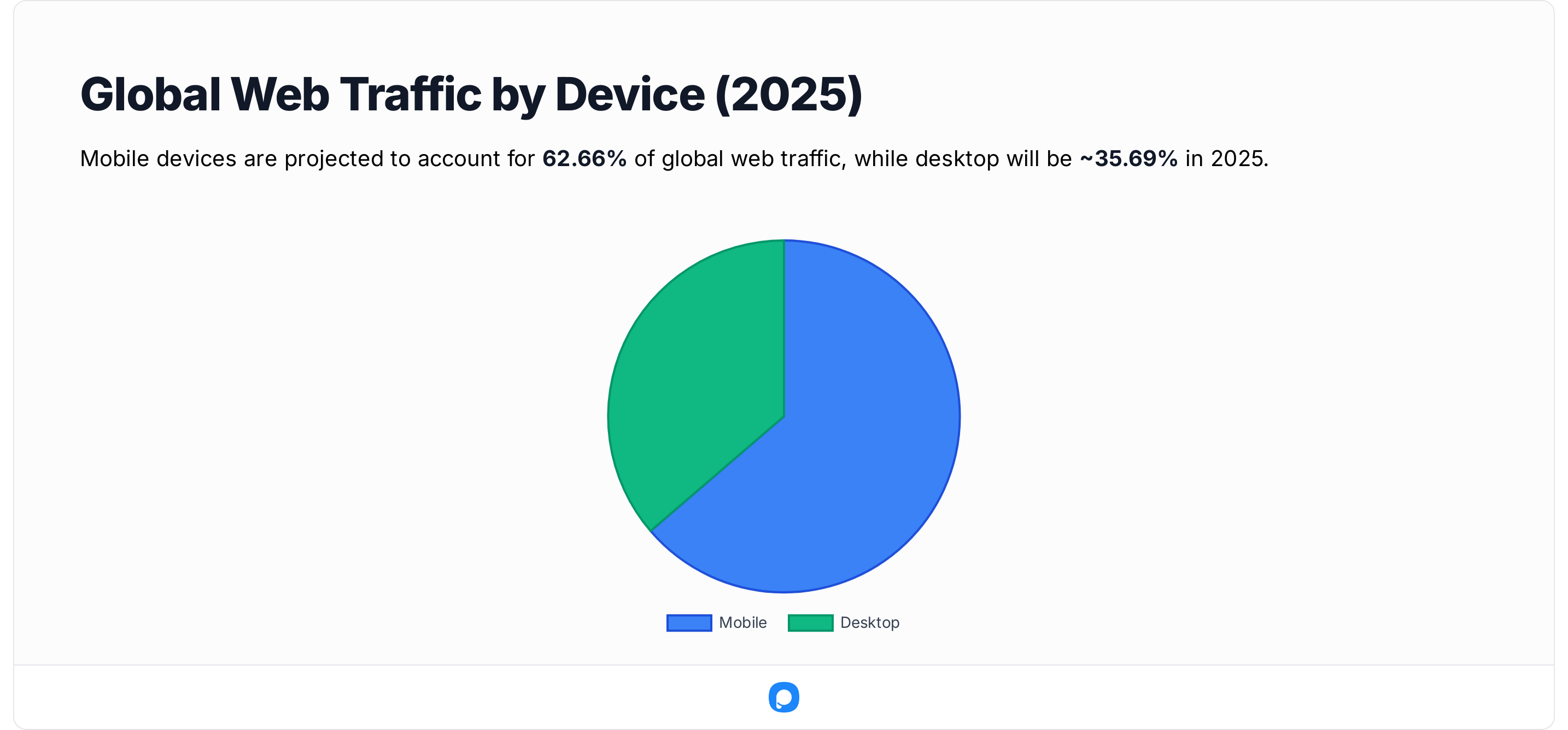
⏱ Session Length & Engagement: Depth vs. Speed
- A study by Semrush reveals that in 2023 desktop sessions lasted between ~996–1,918 seconds, whereas mobile sessions were shorter (704–775 seconds range). This means desktop visitors generally spend significantly more time per visit than mobile users.
- Another source from Taboola reports that ~70% of mobile web sessions last 3.5 minutes or less, indicating how fleeting mobile browsing can be.
- In my experience, these numbers track perfectly with our popup data: mobile high interactions but faster exits; desktop fewer but longer interactions.
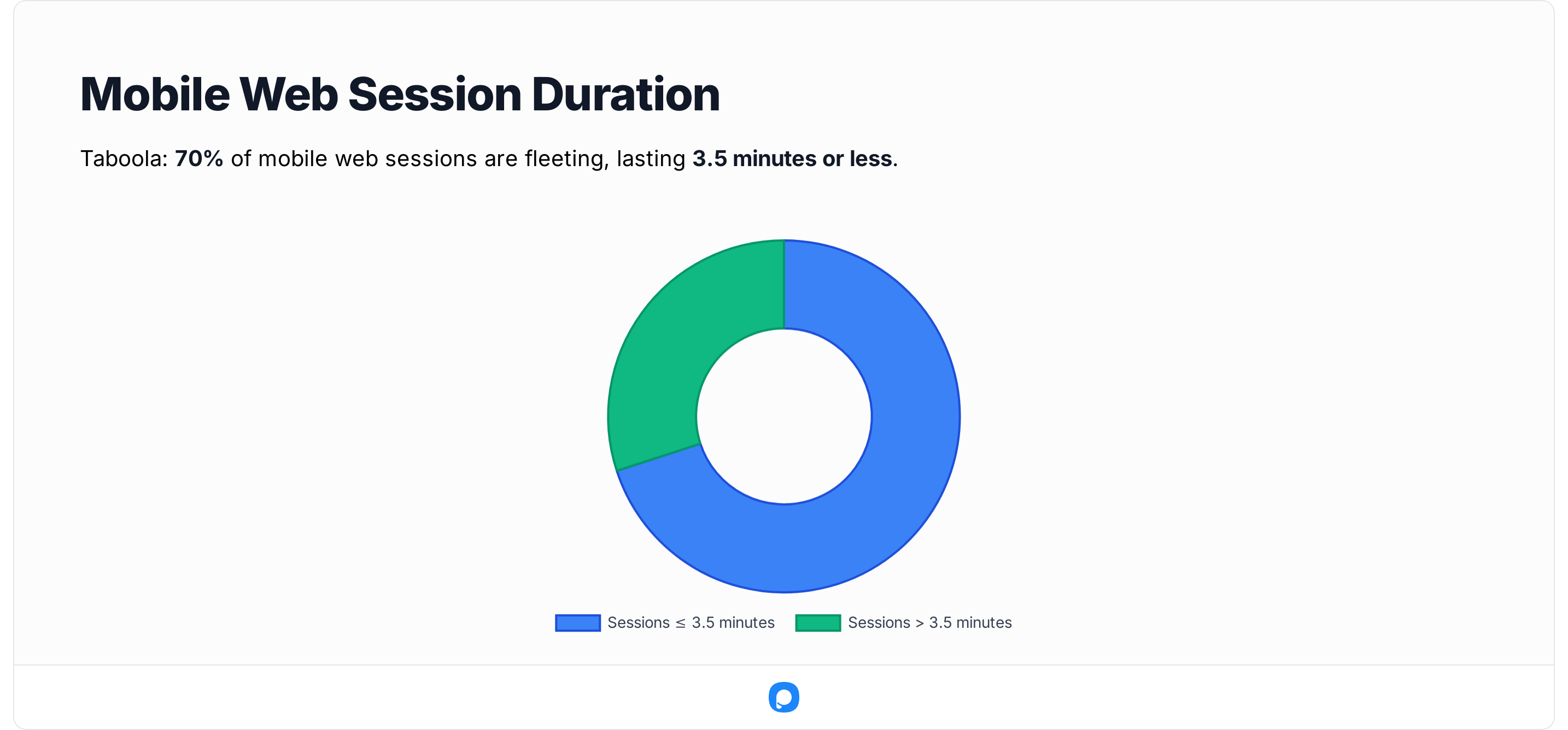
📉 Bounce Rates & Page Depth: Higher Risk on Mobile
- According to mobile vs desktop statistics from SQ Magazine, mobile bounce rates average around 54.3%, whereas desktop bounce rates are closer to 42.8%.
- Shorter sessions + higher bounce rates on mobile mean that interruptive popups or heavy forms face high risk of abandonment.

🔍 User Intent & Device Purpose: What the Data Suggests
- Desktop use tends to coincide with task-oriented sessions — people researching, comparing, signing up, purchasing. That aligns with longer dwell time and higher conversion potential documented above.
- Mobile use often aligns with micro-moments — checking quickly, switching apps, browsing while distracted. That means popups must meet users in their moment, not ask them to slow down drastically.
- A study covering mobile-phone session trajectories shows that mobile behaviour is often fragmented, with frequent short sessions and re-entry patterns rather than one long uninterrupted use.
🧠 My Reflections on These Trends
From my vantage point, the research reinforces the following:
- Popups on mobile have a smaller window for impact, because users are moving fast, multi-tasking, or using devices in transit.
- Desktop popups have a larger window to build context, trust, and more complex offers, because the user is giving more time and attention.
- If a popup strategy treats both devices identically, it’s inherently leaving performance on the table, because the browsing behaviour context has changed.
🏁 Conclusion: Bridging the Mobile–Desktop Gap
After analyzing over 50 million popup sessions and cross-referencing them with global UX and traffic data, one truth keeps coming back to me:
the same popup will never perform equally on two different screens.
Mobile and desktop visitors think differently, move differently, and decide differently.
Mobile users act in micro-moments; fast, curious, and impatient. Desktop users engage in longer, focused sessions — slower, but with higher intent.
That’s why real optimization today isn’t about designing “responsive popups.” It’s about designing responsive experiences, popups that adapt not only in size but in strategy:
- When they appear
- What they say
- How much effort they demand
The future of high-performing campaigns lies in understanding that timing, context, and cognitive load matter more than form design or color choices.
If there’s one takeaway from 50 million sessions, it’s this:
Popups don’t interrupt conversions, bad timing does.
The brands that internalize that difference will own the next phase of conversion optimization.
❓FAQs
1. Why do mobile popups usually convert less than desktop popups?
Because mobile users browse faster and multitask more. Their sessions are shorter, and they tend to interact impulsively. Converting them requires fewer steps and perfectly timed, lightweight popups.
2. When should I show a popup on desktop?
Desktop users prefer timing that feels “earned.” The sweet spot is around 8–12 seconds of dwell time or once a user has scrolled at least halfway down a page. Exit-intent popups also perform well when they match the visitor’s context.
3. What’s the ideal popup timing for mobile?
The most effective mobile triggers fire 5–7 seconds after engagement or 20–30% down the page. Never display popups instantly on page load, they often double bounce rates.
4. Should I use the same design for mobile and desktop?
No. Mobile popups should be compact, gesture-friendly, and visually clean. Desktop popups can use richer visuals, multi-step flows, and slightly longer copy because users have more screen space and attention span.
5. What’s next for popup optimization?
The next wave is adaptive timing powered by AI. Instead of fixed delays, popups will soon trigger based on live behavioral signals — scroll velocity, cursor hesitation, tap frequency — making engagement feel natural rather than forced.
✅ Final Note:
From this analysis, one thing is clear: success in 2025 isn’t about showing more popups. It’s about showing the right popup, at the right time, on the right device.
That’s the difference between a visitor who closes the window and one who converts.
